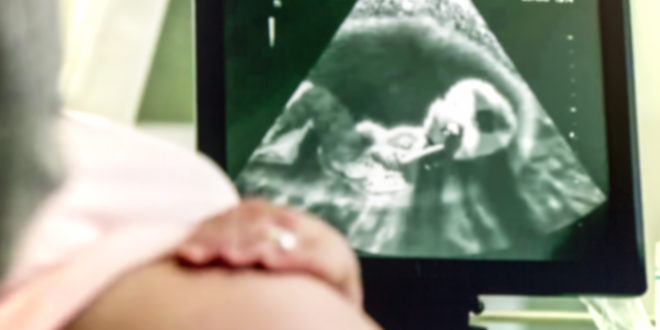Down syndrome is the most common inherited cause of mental retardation. Prenatal aneuploidy screening can be done in the first or second trimester of pregnancy to evaluate the risk of Down syndrome and other genetic conditions in the fetus. By the time a mother knows she is pregnant, the karyotype of the fetus has been decided. So, prenatal screening can’t prevent a pregnancy with Down baby, but is important from a different perspective. It helps identify the risk of having a baby with the condition in the present pregnancy and provide the option of termination if found affected on further evaluation. It also brings huge reassurance to those who are found to be at low risk.
 Who should be tested?
Who should be tested?
In the 1960s, it was identified that advanced maternal age has a strong epidemiological link to risk of Down syndrome. The risk increases with age and becomes high after 35 years of age. As a result, screening is often offered to women 35 years and older or with previous history of Down syndrome pregnancy only. However, most pregnancies happen in younger mothers, and more children with Down syndrome are born to younger mothers. Maternal age has a detection rate of just 30 percent. Thus, 70 percent of Down syndrome cases occur in women younger than 35 years of age. Thus, age as screening test is not the ultimate criteria to identify Down syndrome cases, says Dr. Deepika Jindal, MD, Manager-Medical and Scientific Affairs, Roche Diagnostics India. “One can miss out 70 percent of Down syndrome cases by using age as a selection criterion to recommend screening. Therefore, international guidelines recommend universal screening, i.e. all pregnant women should be offered screening for Down syndrome,” she suggests.
How are they tested?
The ideal scenario would have been to offer a definitive diagnostic test to all women, wherein a woman is offered a test, and if the test is positive, she is given an option to terminate or continue with the pregnancy. However, such tests are invasive and have a small but definite risk of miscarriage (0.5 – 2 %), infection, and limb reduction defects, says Dr. Jindal. “Also, they are expensive and these invasive tests can’t be offered to all pregnant women. So, the practical approach is to derive a personalized risk for a woman, and if she seems to be at high risk, then the invasive test can be offered to that high-risk mother alone.”
The personalized risk is obtained through screening tests. Screening tests have high sensitivity and are noninvasive, with no risk of miscarriage or other pregnancy complications. Though they don’t give a definitive answer as to whether a baby has Down syndrome, they give the risk, and are used to help doctors decide whether further diagnostic tests are necessary.
What are the criteria of identifying women at high risk?
Different screening filters are applied to identify women who might be at risk of carrying a Down’s baby. These are maternal age, fetal ultrasound markers, and maternal serum biochemistry. Maternal age gives only a statistical risk. According to Dr. Jindal, any woman who is 35 years of age has 1 in 350 risk of having a baby affected by Down syndrome. But, in reality, one woman might be having 1 in 10,000 risk, while the other might be having 1 in 40 risk. It depends on the individual. “So,” she says, “we need the help of fetal ultrasound markers and maternal serum biochemistry to convert this statistical risk into personalized risk for an individual.”
What are the screening models?
There are three types of screening models: first-trimester screening (FTS), second-trimester screening, and combined first- and second-trimester screening.
Prenatal aneuploidy screening has really evolved since the 1960s, from maternal age, alfa-fetoprotein (AFP), triple marker, quadruple marker, and first trimester screening, to the latest non-invasive prenatal testing (NIPT), which is based on fetal cell-free DNA. First trimester screening with double markers (free beta hCG and PAPP-A) is considered the standard for Down syndrome screening for more than two decades now. Dr. Jindal says. “If you use only age as the screening test, you will get 30 percent detection rate. If you add double markers to it, you will get about 50 percent sensitivity. Adding nuchal translucency to it will get you to 82-87 percent detection rate. And, further adding other USG markers like nasal bone, tricuspid flow, or ductus venosus flow will get you a 92-95 percent detection rate.”
“This is what is advised in developing countries—do simple blood tests and simple USG markers to get 92-95 percent detection rate. The two markers: free B hCG and PAPP-A, which are done by the lab, USG by the gynecologist or radiologist, and all these are put into a software to get the risk for the woman.”
“Compared to the second trimester models (quadruple or triple tests) that have 60-70% detection rate, first trimester screening has a better detection rate. Second trimester screening (quadruple test preferred) is offered only when the woman has reported late in the pregnancy post the FTS window,” she informs.
What is the best time to do the screening?
“First trimester screening offers possibility of early diagnostic testing by chorionic villus sampling (CVS), optimum time for NIPT and option of first trimester termination, and of course, most importantly, the detection rate is higher. Hence, first trimester is the best time for screening,” Dr. Jindal says.
 Medicosnext
Medicosnext




